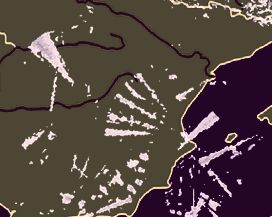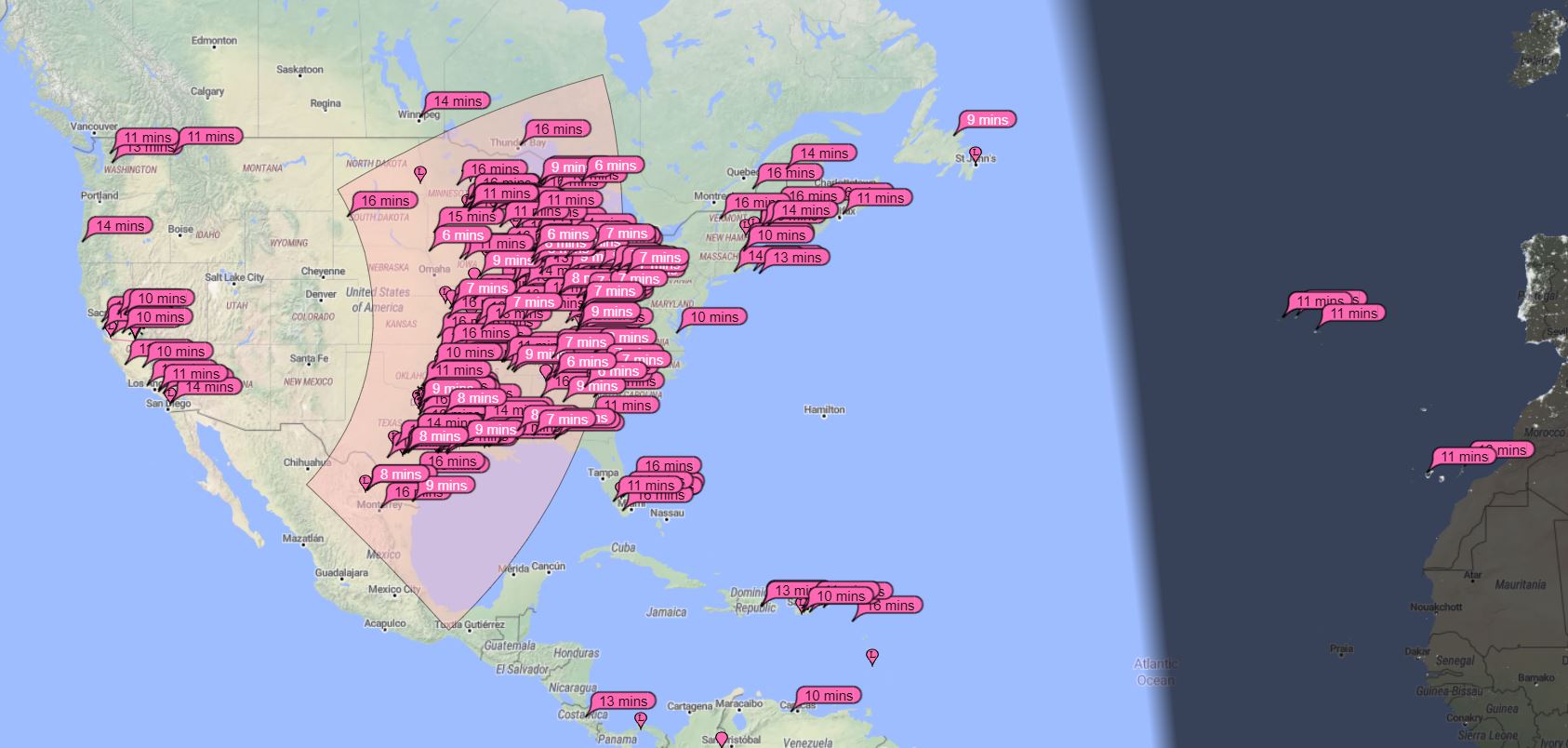|
Very-high-frequency
Very high frequency (VHF) is the International Telecommunication Union, ITU designation for the range of radio frequency electromagnetic waves (radio waves) from 30 to 300 megahertz (MHz), with corresponding wavelengths of ten meters to one meter. Frequencies immediately below VHF are denoted high frequency (HF), and the next higher frequencies are known as ultra high frequency (UHF). VHF radio waves propagate mainly by line-of-sight propagation, line-of-sight, so they are blocked by hills and mountains, although due to refraction they can travel somewhat beyond the horizon, visual horizon out to about 160 km (100 miles). Common uses for radio waves in the VHF band are Digital Audio Broadcasting (DAB) and FM radio broadcasting, Terrestrial television, television broadcasting, two-way radio, two-way land mobile radio systems (emergency, business, private use and military), long range data communication up to several tens of kilometers with radio modems, amateur radio, and ... [...More Info...] [...Related Items...] OR: [Wikipedia] [Google] [Baidu] |
Megahertz
The hertz (symbol: Hz) is the unit of frequency in the International System of Units (SI), equivalent to one event (or Cycle per second, cycle) per second. The hertz is an SI derived unit whose expression in terms of SI base units is s−1, meaning that one hertz is the reciprocal of one second. It is named after Heinrich Hertz, Heinrich Rudolf Hertz (1857–1894), the first person to provide conclusive proof of the existence of electromagnetic waves. Hertz are commonly expressed in metric prefix, multiples: kilohertz (kHz), megahertz (MHz), gigahertz (GHz), terahertz (THz). Some of the unit's most common uses are in the description of periodic waveforms and musical tones, particularly those used in radio- and audio-related applications. It is also used to describe the clock speeds at which computers and other electronics are driven. The units are sometimes also used as a representation of the photon energy, energy of a photon, via the Planck relation ''E'' = ''hν'', ... [...More Info...] [...Related Items...] OR: [Wikipedia] [Google] [Baidu] |
Marine VHF Radio
Marine VHF radio is a worldwide system of two way radio transceivers on ships and watercraft used for bidirectional voice communication from ship-to-ship, ship-to-shore (for example with harbormasters), and in certain circumstances ship-to-aircraft. It uses FM channels in the very high frequency (VHF) radio band in the frequency range between 156 and 174 MHz, inclusive, designated by the International Telecommunication Union as the ''VHF maritime mobile band''. In some countries additional channels are used, such as the L and F channels for leisure and fishing vessels in the Nordic countries (at 155.5–155.825 MHz). Transmitter power is limited to 25 watts, giving them a range of about . Marine VHF radio equipment is installed on all large ships and most seagoing small craft. It is also used, with slightly different regulation, on rivers and lakes. It is used for a wide variety of purposes, including marine navigation and traffic control, summoning rescue servic ... [...More Info...] [...Related Items...] OR: [Wikipedia] [Google] [Baidu] |
Two Way Radio
A two-way radio is a radio that can both transmit and receive radio waves (a transceiver), unlike a broadcast receiver which only receives content. It is an audio (sound) transceiver, a transmitter and receiver in one unit, used for bidirectional person-to-person voice communication with other users with similar radios. Two-way radios are available in stationary ( base station), mobile (installed in vehicles), and hand-held portable models. Hand-held two-way radios are often called walkie-talkies, handie-talkies or hand-helds. Two-way radios are used by groups of geographically separated people who need to keep in continuous voice communication, such as aircraft pilots and air traffic controllers, ship captains and harbormasters, emergency services personnel like firefighters, police officers, and ambulance paramedics, taxi and delivery services, soldiers and military units, fast food and warehouse employees, and radio amateurs. Two-way radio systems may use a single radio chan ... [...More Info...] [...Related Items...] OR: [Wikipedia] [Google] [Baidu] |
Radio Frequency Interference
Electromagnetic interference (EMI), also called radio-frequency interference (RFI) when in the radio frequency spectrum, is a disturbance generated by an external source that affects an electrical circuit by electromagnetic induction, electrostatic coupling, or conduction. The disturbance may degrade the performance of the circuit or even stop it from functioning. In the case of a data path, these effects can range from an increase in error rate to a total loss of the data. Both man-made and natural sources generate changing electrical currents and voltages that can cause EMI: ignition systems, cellular network of mobile phones, lightning, solar flares, and auroras (northern/southern lights). EMI frequently affects AM radios. It can also affect mobile phones, FM radios, and televisions, as well as observations for radio astronomy and atmospheric science. EMI can be used intentionally for radio jamming, as in electronic warfare. History Since the earliest days of radi ... [...More Info...] [...Related Items...] OR: [Wikipedia] [Google] [Baidu] |
Radio Noise
In radio reception, radio noise is unwanted random radio frequency electrical signals, fluctuating voltages, always present in a radio receiver in addition to the desired radio signal. Radio noise near in frequency to the radio signal being received (in the receiver's passband) interferes with it in the receiver's circuits. Radio noise is a combination of natural electromagnetic atmospheric noise ("spherics", static) created by electrical processes in the atmosphere like lightning, manmade radio frequency interference (RFI) from other electrical devices picked up by the receiver's antenna, and thermal noise present in the receiver input circuits, caused by the random thermal motion of molecules. The level of noise determines the maximum sensitivity and reception range of a radio receiver; if no noise were picked up with radio signals, even weak transmissions could be received at virtually any distance by making a radio receiver that was sensitive enough. With noise present, if a ... [...More Info...] [...Related Items...] OR: [Wikipedia] [Google] [Baidu] |
Multipath Propagation
In radio communication, multipath is the propagation phenomenon that results in radio signals reaching the receiving antenna by two or more paths. Causes of multipath include atmospheric ducting, ionospheric reflection and refraction, and reflection from water bodies and terrestrial objects such as mountains and buildings. When the same signal is received over more than one path, it can create interference and phase shifting of the signal. Destructive interference causes fading; this may cause a radio signal to become too weak in certain areas to be received adequately. For this reason, this effect is also known as multipath interference or multipath distortion. Where the magnitudes of the signals arriving by the various paths have a distribution known as the Rayleigh distribution, this is known as Rayleigh fading. Where one component (often, but not necessarily, a line of sight component) dominates, a Rician distribution provides a more accurate model, and this is known as Ri ... [...More Info...] [...Related Items...] OR: [Wikipedia] [Google] [Baidu] |
Ground Wave
Ground waves are radio waves propagating parallel to and adjacent to the surface of the Earth, following the curvature of the Earth. This radiation is known as Norton surface wave, or more properly Norton ground wave, because ground waves in radio propagation are not confined to the surface. Overview Lower frequency radio waves, below 3 MHz, travel efficiently as ground waves. In ITU nomenclature, this includes (in order): medium frequency (MF), low frequency (LF), very low frequency (VLF), ultra low frequency (ULF), super low frequency (SLF), extremely low frequency (ELF) waves. Ground propagation works because lower-frequency waves are more strongly diffracted around obstacles due to their long wavelengths, allowing them to follow the Earth's curvature. Ground waves propagate in vertical polarization, with their magnetic field horizontal and electric field (close to) vertical. Conductivity of the surface affects the propagation of ground waves, with more conductive su ... [...More Info...] [...Related Items...] OR: [Wikipedia] [Google] [Baidu] |
Skywave
In radio communication, skywave or skip refers to the propagation of radio waves reflected or refracted back toward Earth from the ionosphere, an electrically charged layer of the upper atmosphere. Since it is not limited by the curvature of the Earth, skywave propagation can be used to communicate beyond the horizon, at intercontinental distances. It is mostly used in the shortwave frequency bands. As a result of skywave propagation, a signal from a distant AM broadcasting station, a shortwave station, or – during sporadic E propagation conditions (principally during the summer months in both hemispheres) a distant VHF FM or TV station – can sometimes be received as clearly as local stations. Most long-distance shortwave (high frequency) radio communication – between 3 and 30 MHz – is a result of skywave propagation. Since the early 1920s amateur radio operators (or "hams"), limited to lower transmitter power than broadcast stations, have ta ... [...More Info...] [...Related Items...] OR: [Wikipedia] [Google] [Baidu] |
Ionosphere
The ionosphere () is the ionized part of the upper atmosphere of Earth, from about to above sea level, a region that includes the thermosphere and parts of the mesosphere and exosphere. The ionosphere is ionized by solar radiation. It plays an important role in atmospheric electricity and forms the inner edge of the magnetosphere. It has practical importance because, among other functions, it influences radio propagation to distant places on Earth. History of discovery As early as 1839, the German mathematician and physicist Carl Friedrich Gauss postulated that an electrically conducting region of the atmosphere could account for observed variations of Earth's magnetic field. Sixty years later, Guglielmo Marconi received the first trans-Atlantic radio signal on December 12, 1901, in St. John's, Newfoundland (now in Canada) using a kite-supported antenna for reception. The transmitting station in Poldhu, Cornwall, used a spark-gap transmitter to produce a signal with a freq ... [...More Info...] [...Related Items...] OR: [Wikipedia] [Google] [Baidu] |
Digital Television Transition
The digital television transition, also called the digital switchover (DSO), the analogue switch/sign-off (ASO), the digital migration, or the analogue shutdown, is the process in which older analogue television broadcasting technology is converted to and replaced by digital television. Conducted by individual nations on different schedules, this primarily involves the conversion of analogue terrestrial television broadcasting infrastructure to digital terrestrial (DTT), a major benefit being extra frequencies on the radio spectrum and lower broadcasting costs, as well as improved viewing qualities for consumers. The transition may also involve analogue cable conversion to digital cable or Internet Protocol television, as well as analog to digital satellite television. Transition of land based broadcasting was begun by some countries around 2000. By contrast, transition of satellite television systems was well underway or completed in many countries by this time. It is an inv ... [...More Info...] [...Related Items...] OR: [Wikipedia] [Google] [Baidu] |
Analog Television
Analog television is the original television technology that uses analog signals to transmit video and audio. In an analog television broadcast, the brightness, colors and sound are represented by amplitude, instantaneous phase and frequency, phase and frequency of an analog signal. Analog signals vary over a continuous range of possible values which means that Noise (electronics), electronic noise and interference may be introduced. Thus with analog, a moderately weak signal becomes Noise (video), snowy and subject to interference. In contrast, picture quality from a digital television (DTV) signal remains good until the signal level drops below digital cliff, a threshold where reception is no longer possible or becomes intermittent. Analog television may be wireless (terrestrial television and satellite television) or can be distributed over a cable network as cable television. All broadcast television systems used analog signals before the arrival of DTV. Motivated by the ... [...More Info...] [...Related Items...] OR: [Wikipedia] [Google] [Baidu] |
Band I
Band I is a range of radio frequencies within the very high frequency (VHF) part of the electromagnetic spectrum. The first time there was defined "for simplicity" in Annex 1 of "Final acts of the European Broadcasting Conference in the VHF and UHF bands - Stockholm, 1961". Band I ranges from 47 to 68 MHz for the European Broadcasting Area, and from 54 to 88 MHz for the Americas and it is primarily used for television broadcasting in compliance with ITU Radio Regulations (article 1.38). With the transition to digital TV, most Band I transmitters have already been switched off. Television broadcasting usage Channel spacings vary from country to country, with spacings of 6, 7 and 8 MHz being common. In the UK, Band I was originally used by the BBC for monochrome 405-line television; likewise, the French former 455-line (1937-1939) then 441-line (1943-1956) transmitter on the Eiffel Tower in Paris, and some stations of the French monochrome 819-line system used Band I. Both 405-lin ... [...More Info...] [...Related Items...] OR: [Wikipedia] [Google] [Baidu] |







